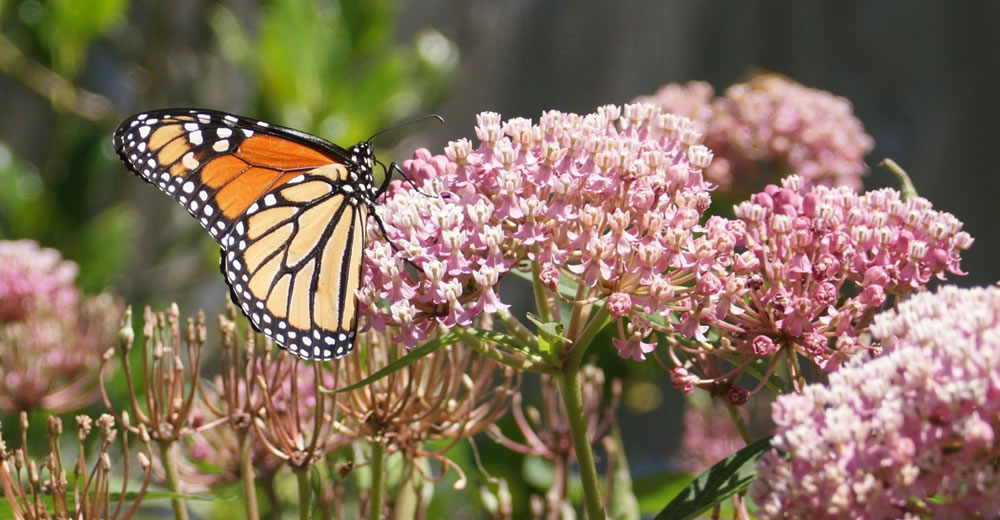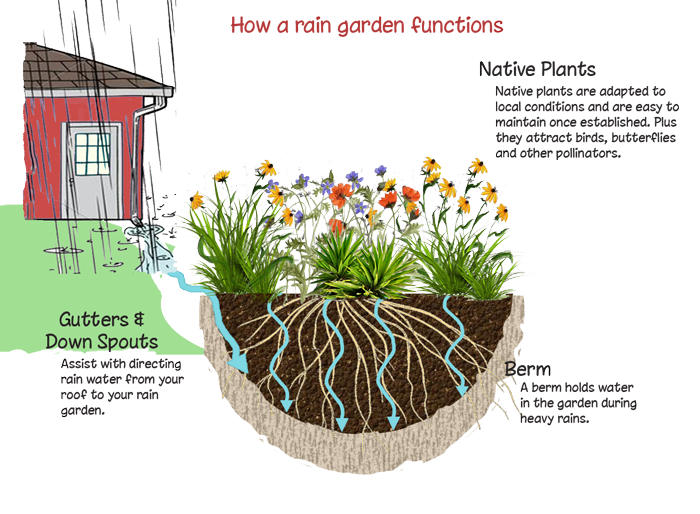Rain Gardens
- Home
- /
- Our Work
- /
- Education
- /
- Living Landscape Laboratory
- /
- Rain Gardens

What is a rain garden?
A rain garden is a shallow depression that is planted with deep-rooted native plants and grasses. Rain gardens are often designed to capture roof runoff from a gutter downspout. Here’s a short video of APCC’s rain garden (Vimeo) in a rain storm.
Why have a rain garden?
Rainwater that flows over roofs, driveways and other hard surfaces collects pollutants that accumulate from windblown dust, fluids from vehicles, lawn chemicals, and sometimes from the materials of which these surfaces are made. In general, Cape Cod soils are sandy and therefore rainwater percolates down into the groundwater quite readily. Our groundwater is our drinking water and groundwater ultimately flows into our estuaries. Its purity is critically important to the health of Cape Cod.
Plants play an important role in purifying water. Our deep-rooted native grasses, perennials, shrubs and trees are capable of taking in excess nutrients, breaking down pollutants and holding them in place & out of our drinking water. The roots of our lawns only penetrate a few inches into the ground whereas native grasses, such as switch grass, can reach to six feet beneath the surface. Their deep roots promote water infiltration and tolerance of drought.
 APCC’s rain garden is an example of one stormwater management technique. It also is a means to showcase the beauty of native plants as well as their ecological value.
APCC’s rain garden is an example of one stormwater management technique. It also is a means to showcase the beauty of native plants as well as their ecological value.
Everyone should have a rain garden! Here’s where you, as a homeowner, can start:
Look for a location that will give the rain garden a purpose!
A rain garden can be to:
- Collect water from a gutter downspout
- Address an area of puddling that occurs in a rainstorm
- Direct and capture rainwater from a hard surface (like a driveway) to keep the water on the property.
APCC’s rain garden was installed to capture roof runoff from a gutter downspout.
Investigate and determine the suitability of the location
Ask these questions:
- Where is your septic system? You want to avoid installing a garden over any part of it. Your local health department should be able to provide you with this information.
- Are there underground utilities? Before you dig, call DIGSAFE at 811. It is a free service. Someone will come out to your property and flag any buried public gas, cable or electric services.
What are the soils like in the proposed location? Dig a hole about 24-30 inches below the surface to see if soils are sandy. If so, this means your rain garden will function properly. However, if you find clay or soil that is very compact so that water doesn’t absorb quickly, you may want to consider another location where soils are suitable or you can dig the garden a little deeper and bring in sandy soil. Fortunately, here on Cape Cod most of us have sandy soils. - How big does the rain garden need to be? You’ll have to do some math. Measure the area on which rain falls that drains to your rain garden and figure out the square footage (approximate area is okay). Then for some help, check out this online calculation tool and plug in ? to 1 inch of rain to determine the volume of rain for which you should plan. With the volume of your rain garden determined, now you just need to figure out how large an area will handle the volume of water. But it’s not rocket science when you’re just handling rain from a residential roof. A guesstimate will work.
- Can the rain garden be located 6-10ft away from the house’s foundation? It’s never a good idea to have roof runoff puddling against the foundation as this can result in a damp basement.
All set? DIG
TIP. Use a garden hose or rope or stakes to help layout the shape and dimensions of your garden.
The soil type will determine the depth of excavation and needed organic amendments like leaf mulch that will provide some nutrients and assure some moisture retention in the dry months to keep plants happy.
The APCC garden was excavated by hand to a depth of 18 inches. Because of the lack of organics in our soils (soils are very sandy), we brought in a locally sourced natural leaf mulch, mixed the mulch with the excavated soils in a 50/50 ratio and then returned it to the garden hole.
APCC’s land slopes slightly. In order to insure the rain garden would contain a significant amount of water in a severe storm event, the extra soil we excavated was placed along the lower rim of the garden depression. The mound or berm created was about 4-6inches high. This will serve to hold water in the garden if it were ever to fill.
Getting the rainwater to the garden
There are a couple of different ways to get the water from the downspout to the rain garden (and away from the foundation). One is a trench lined with something water cannot seep through, filled with gravel or river rock to slow the water flow. Alternately, a pvc pipe or gutter extension which can be covered with soil and planted or otherwise hidden.
At APCC, we hand dug a trench that sloped toward the garden that was over six feet away. We lined it with a piece of a rubber pond liner and covered with 3/4inch stone. This directs the water to where we want it, in the garden.
Plant Selection
Determine what the sun exposure is for the site selected. As with planning any garden, it is key to know how much sun the area receives. This will help you choose the appropriate native plants.
These are the plants that APCC has in its rain garden. The APCC garden will receive full sun. All are native, but some are cultivars. A cultivar is a variety of a plant whose desirable traits, such as height and color, have been selected through plant breeding. These are often the native plants you will find at retail nurseries.
The perennials on this list are good nectar producers for pollinators; they are host plants for caterpillars that make butterflies; and they will provide seeds for birds. The red fruits of the winterberry will be food for birds in late winter. And the sedge will help keep weeds down and fill in the bare spaces. All will give “winter interest” in the landscape.
Perennials
Joe-Pye Weed “Little Joe” (Eutrochium dubium)
Boneset (Eupatorium perfoliatum)
Liatris “Floristan Violet” (Liatris spicata)
Purple Coneflower (Echinacea purpurea)
Black-eyed Susan (Rudbeckia fulgida)
Aromatic Aster “October Skies” (Symphyotrichum oblongifolium)
Path Rush (Juncus tenuis)
Swamp Milkweed (Asclepias incarnata)
Wild Bergamot (Monarda fistulosa)
Shrubs
Winterberry “Red Sprite”; the female with berries (Ilex verticillata)
Winterberry “Jim Dandy”; the male to ensure berries
Groundcover
Pennsylvania Sedge (Carex pensylvanica)
For more rain garden information see these online sources:


